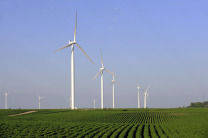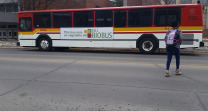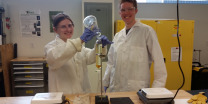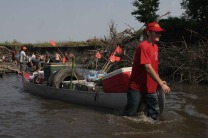AMES, Iowa – Conservation, sustainability, eco-friendly – more than just buzz words, these are principles Merry Rankin is making part of the campus culture at Iowa State University. As director of sustainability, she sees Earth Day as an opportunity to get more students, faculty and staff involved in ISU’s Live Green! Initiative.
“It’s great to have a day, week or month to get people excited and interested in sustainability, but we hope they find something they really want to do or try,” Rankin said. “It only takes a small step to empower and get people looking at other ways they can continue to make a difference.”
Rankin and several student organizations are hosting a Live Green! Celebration from 11 a.m. to 2 p.m. Wednesday, Earth Day, April 22, on the Parks Library Lawn. The event will feature interactive exhibits, free bike tune-ups and a prototype bicycle for CyBike – a bike-share initiative – on display.
Here’s a list of other activities and ongoing efforts at Iowa State to make campus as “green” as possible.
Energy efficiency
Iowa State has reduced total energy use by 8 percent since fiscal year 2008. That may sound like a small amount, but consider the record growth in student enrollment and construction of new buildings during that time frame. Rankin credits energy-efficient designs and a conscious effort by students, faculty and staff.
“Heating and cooling always depends on the weather, but electricity is interesting to watch because it is not solely dependent on the seasons. Electricity consumption has everything to do with personal choice and the efficiency of our operational systems,” Rankin said.

Wind energy generates 7 percent of the electricity for campus. And Iowa State projects it will reduce carbon emissions by 15 percent with renovations to the university’s power plant. Rankin says ISU continues to look at renewable energy sources to reduce emissions and reliance on coal.
Dining and residence halls
ISU Dining has implemented several successful initiatives as part of its ongoing sustainability efforts and to reduce waste. Here are a few examples:
- Farm to ISU: ISU Dining dedicates around 10 percent of its annual budget to support local farmers and producers and increase the amount of local and organic options it offers. For fiscal year 2014, 72 percent of Farm to ISU spending was dedicated to Iowa-made items, such as AE Dairy and Cookies BBQ. Another 10 percent of Farm to ISU spending purchased Iowa farm products, such as Deal’s Orchard apples and Moenck Honey.
- Re-usable cup discount: ISU Dining rewards customers with a 35-cent discount for any beverage when they bring their own cup. The discount program was launched in 2010 after a study found disposable cups made up the majority of the waste in dumpsters near dining cafes. The program saved 42,547 cups – or $14,891.45 – from discounts given during 2012-2013.
- Composting program: Instead of throwing out food waste from campus dining centers, it is sent to the ISU Compost Facility. The compost is used for beautification projects around campus. In 2011, 396.95 tons of food waste was diverted from the landfill.
- Food at First partnership: Unpurchased, packaged food items near their sell-by date from ISU Dining retail locations are donated to Food at First – a free meal program and food pantry that serves Story County.
The Department of Residence also has a recycling program in all residence halls to keep cardboard, plastics, paper and redeemable cans and bottles from ending up in the landfill. And with the end of the school year approaching, students can donate unwanted furniture and other items through the SAVE program.
SAVE (Simple Act Vital Effect) collects clean, gently used clothing, small appliances or household items, and unopened food that students no longer need or don’t want to move. The items are taken to local charitable organizations. Non-perishable food items are donated to local food pantries. A list of drop-off locations can be found here: www.housing.iastate.edu/life/sustainability/save-program.
ISU BioBus

Photo courtesy Bailley Richardson
This student-led initiative recycles vegetable oil from ISU dining centers and converts the used oil into biodiesel for CyRide. The ISU BioBus Club produces around 40 gallons every academic year that CyRide blends with diesel fuel, providing a non-toxic alternative to fossil fuels that reduces emissions.
“It’s great that we can take something that’s a waste product and make it into something that is really valuable and is not going into a landfill. It’s something you can re-use,” said Bailley Richardson, president of the club.

Members of the ISU BioBus making biofuel in the lab. Photo courtesy of Bailley Richardson
Producing and promoting a sustainable biofuel is the club’s primary goal, but students also provide outreach to local schools and community groups to teach others about the conversion process. The club also gives ISU students experience outside of the classroom.
“I really wanted to get hands-on experience,” said Andrew Towey, the club’s engineering president. “I’ve learned everything about producing small-batch biodiesel and now I’m teaching other students.”
Paying it forward
An important aspect of sustainability that people tend to overlook is community service, Rankin said. There are numerous projects and student organizations. Here are just a few:
- The Alternative Breaks program is a popular option for students wanting to give back and travel over winter or spring break. This academic year, 88 students participated and logged 3,360 hours of community service.
- The Shop is a student-run, on-campus food pantry that provides non-perishable food for ISU students and staff, regardless of need. It’s located in the Food Sciences Building and is open three days a week. The pantry serves around 40-50 students a month.

Skunk River Navy volunteers fill canoes with trash pulled from the Skunk River. Photo courtesy of Jim Colbert.
- The Skunk River Navy has removed more than 72 tons of trash from the Skunk River with the help of 2,100 volunteers since it started in 1998. This service project for students in the BEST (Biology Education Success Teams) Learning Community also teaches students about the biodiversity of Iowa’s rivers. Students have collected more than 30 sets of benthic macro-invertebrate data.
Iowa State University Museums and the Lectures Program also have exhibits and events planned related to Earth Week.
For a full list of Earth Month events on campus and the Ames community, as well as sustainability tips, news and events throughout the year, visit the Live Green! website: www.livegreen.iastate.edu.
